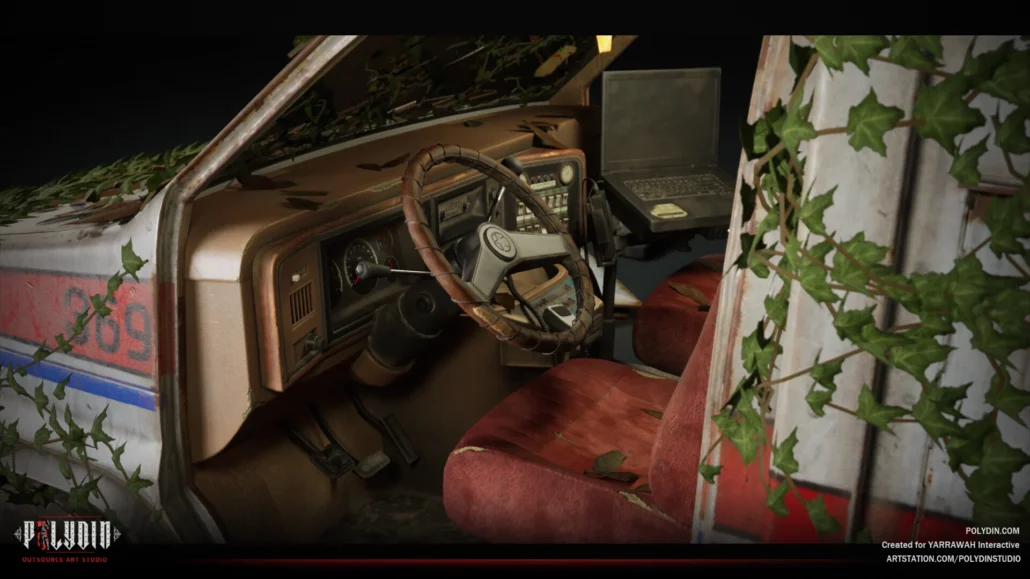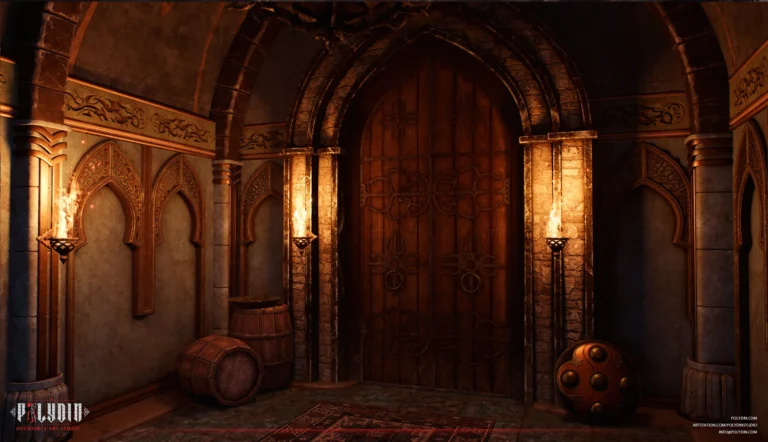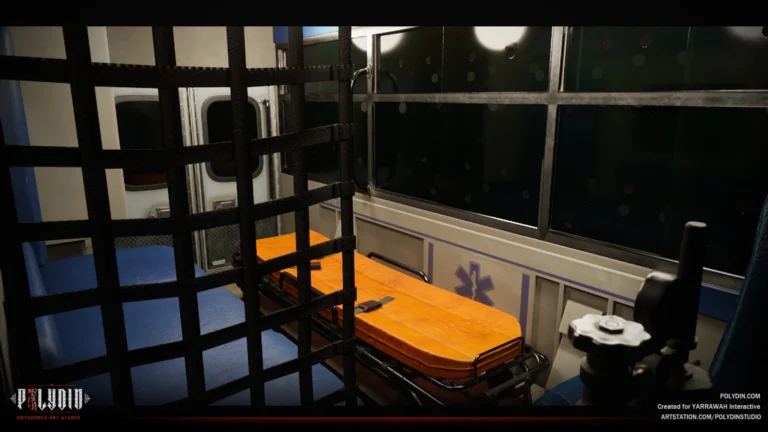In the world of 3D modeling, technical skill alone isn’t enough to create compelling visuals. Whether you’re designing characters, environments, or product renders, the secret to making your work truly stand out lies in composition—the deliberate arrangement of elements within your scene. Good composition in 3D modeling guides the viewer’s eye, evokes emotion, and creates a sense of depth and balance that elevates the overall impact of your work.
This article by Polydin game art outsourcing studio explores the fundamentals and finer details of composition in 3D modeling, from essential principles like the rule of thirds and symmetry to techniques involving lighting, color, and software tools. No matter what your skill level is, understanding composition will help you craft more intentional, engaging 3D scenes. Let’s break down the building blocks of visual storytelling and learn how to avoid common pitfalls in the process.
Understanding the Basics of Composition in 3D Modeling
Before diving into advanced techniques, it’s important to grasp what composition means in the context of 3D modeling. At its core, composition in 3D modeling refers to the way visual elements are arranged within a three-dimensional space to create a harmonious, engaging, and purposeful scene. This includes decisions about object placement, camera angles, lighting, color usage, and the relationships between foreground, midground, and background elements.
Unlike 2D art or photography, 3D modeling offers complete control over the virtual environment. This means artists must consider not only what the viewer sees, but also how they navigate and interpret the scene in a spatial context. Good composition can make a simple render feel cinematic, while poor composition can render even the most detailed models flat or confusing.
By learning to think compositionally, 3D artists gain a powerful tool for storytelling in games, visual clarity, and emotional impact.
What Is 3D Composition?
3D composition is the art of organizing elements within a three-dimensional space to create a visually pleasing and meaningful image or scene. It involves more than just placing objects—it’s about guiding the viewer’s attention, creating depth, balancing visual weight, and establishing a clear hierarchy of information. In 3D modeling, composition extends to the use of lighting, camera placement, color theory, and even the emptiness around objects (negative space).
What makes composition in 3D modeling unique is the full spatial freedom it offers. Unlike flat mediums, 3D allows you to control how an object looks from any angle and how it interacts with light and space. This adds complexity but also incredible creative potential. Whether you’re building a stylized scene or a photorealistic render, understanding 3D composition helps ensure your final output communicates exactly what you intend, with clarity and impact.
Why Composition Matters in 3D Modeling
Strong composition in 3D modeling is what transforms a technically accurate model into a compelling visual experience. It’s the difference between a render that simply exists and one that tells a story, evokes emotion, or captures attention instantly. No matter how detailed your textures or how high your polygon count, without thoughtful composition, your scene may fall flat or feel disorganized.

Composition shapes how the viewer interacts with your work. It can highlight a character’s expression, direct attention to a key object, or create a mood that supports the scene’s narrative. In game design, animation, and product visualization alike, effective composition also improves usability and clarity, making it easier for audiences to focus on what matters.
Ultimately, composition in 3D modeling is a bridge between technical execution and artistic intent. Mastering it helps you craft images that don’t just look good—they communicate something deeper.
Read Also: Top 3D Modeling Tips and Techniques | Mastering 3D Modeling
Core Principles of 3D Composition
Here are some core principles of 3D composition:
Rule of Thirds
The rule of thirds is a foundational principle in visual art and is just as vital in composition in 3D modeling. Imagine your frame divided into nine equal parts by two horizontal and two vertical lines. Placing key elements along these lines or at their intersections creates a more dynamic and balanced scene than centering everything.
In 3D modeling, applying this rule helps avoid static or awkward compositions. Whether you’re framing a character or showcasing a product, offsetting the subject slightly can introduce movement and tension, guiding the viewer’s eye naturally through the scene.
Balance and Symmetry
Balance refers to the visual weight of elements in a scene, and it plays a crucial role in composition in 3D modeling. A well-balanced composition feels stable and intentional, whether it’s perfectly symmetrical or asymmetrically arranged. Symmetry can create a sense of order, calm, or grandeur, often used in architectural or character design.
Asymmetrical balance, on the other hand, distributes visual weight unevenly but still harmoniously—creating more dynamic and interesting scenes. In 3D modeling, adjusting object sizes, shapes, or lighting can help achieve this. The key is to make sure no part of the scene feels too heavy or too empty without purpose.
Depth and Layering
Creating a sense of depth is essential for making a 3D scene feel immersive and realistic. Composition in 3D modeling thrives when you divide your scene into foreground, midground, and background elements, each with its own role in the visual narrative.
Layering objects helps the viewer understand spatial relationships and scale. For example, placing smaller objects behind larger ones can enhance perspective, while using atmospheric effects like fog or light falloff increases the illusion of distance. Proper use of depth not only adds realism but also improves storytelling by subtly guiding the viewer’s focus through the scene’s spatial hierarchy.
Focal Points and Emphasis
Every strong composition needs a focal point—the area that immediately draws the viewer’s attention. In composition in 3D modeling, this could be a character’s face, a glowing artifact, or a dramatic lighting effect. The focal point should be deliberate and clearly defined, helping to anchor the viewer’s gaze.
You can create emphasis through contrast, scale, color, light, or detail. For example, a brightly lit subject in an otherwise dark scene will naturally stand out. Without a focal point, a scene can feel aimless or cluttered, so always consider what you want your audience to notice first—and why.
Leading Lines and Visual Flow
Leading lines are visual elements—real or implied—that guide the viewer’s eye through a scene. In composition in 3D modeling, they can be roads, architectural edges, beams of light, or even the direction a character is looking. When used effectively, leading lines create a strong sense of movement and narrative.
These lines help establish visual flow, which is the path the viewer’s gaze naturally follows. You can use this to control pacing and emphasis, drawing attention to key elements or building anticipation. Poor flow, on the other hand, can make a scene feel disjointed or overwhelming.
Negative Space
Negative space refers to the empty or unoccupied areas of a scene, which can be just as important as the filled spaces in composition in 3D modeling. It’s not simply “empty space”; it serves to balance the composition, provide breathing room, and guide the viewer’s focus.
In 3D models, negative space can emphasize the subject by creating contrast, preventing overcrowding, and allowing elements to stand out more clearly. Strategic use of negative space can also enhance a sense of scale, depth, and harmony, while cluttered scenes may feel overwhelming or chaotic.
Enhancing Composition in 3D Modeling Through Lighting and Color
Lighting Techniques
Lighting plays a pivotal role in composition in 3D modeling. Not only does it reveal the shapes and textures of your models, but it also sets the mood and guides the viewer’s attention. Effective lighting can highlight focal points, create shadows that add depth, and even influence the emotional tone of a scene.
There are various lighting techniques, such as three-point lighting, which uses a key light, fill light, and backlight to create a balanced and dynamic look. Alternatively, dramatic lighting with high contrast and shadows can evoke mystery or tension, while ambient lighting softens the scene for a more neutral or calming effect. Additionally, the direction and color of the light can help to shape the narrative—for example, warm lighting can evoke a sense of comfort, while cooler tones can suggest isolation or coldness.
Color Theory in 3D Composition
Color is another powerful tool in 3D composition that can influence how the viewer perceives a scene. Understanding color theory allows you to choose colors that work harmoniously and contribute to the emotional impact of your design. Complementary colors, for example, can create contrast and draw attention to key areas, while analogous colors produce a more harmonious, unified look.
In 3D modeling, color also aids in creating depth. Cooler tones tend to recede in space, while warmer tones come forward, helping to simulate distance and layering. Color can also be used to represent character traits or environmental conditions—such as using green tones for a peaceful forest scene or red for a scene filled with danger. The right combination of color and lighting enhances the overall composition, making the scene not only more visually appealing but also more communicative.

Tools and Software for Effective 3D Composition
Here are some tools and software for effective 3D composition:
Blender
Blender is one of the most popular and versatile tools for 3D modeling, offering a comprehensive suite of features for creating and refining compositions. Its scene composition tools allow for precise control over lighting, camera angles, and object placement. Blender’s non-linear workflow makes it especially appealing for artists who want to experiment with composition in real-time. Additionally, its support for high-quality rendering engines like Cycles and Eevee ensures that your composition translates well into the final render, showcasing depth, lighting, and color accurately.
Autodesk Maya and 3ds Max
Both Autodesk Maya and 3ds Max are industry-standard software known for their robustness and precision in 3D modeling and animation. These programs provide advanced features like camera control, lighting setups, and environment management, which are crucial for fine-tuning composition. Maya is particularly favored in animation and film, while 3ds Max excels in architectural visualization and game design. Their vast toolsets help artists manipulate composition through detailed layering and lighting techniques, making them invaluable for professionals.
Cinema 4D
Cinema 4D is widely recognized for its intuitive interface and ease of use, making it a popular choice for 3D artists working in motion graphics, advertising, and visual effects. With powerful camera rigs, lighting controls, and an advanced rendering engine, Cinema 4D allows artists to easily create dynamic compositions that enhance storytelling. Its integration with Adobe products like After Effects also enables seamless transitions from modeling to post-production, making it ideal for projects that involve both 3D composition and motion graphics.
Unreal Engine
Unreal Engine isn’t just a game engine; it’s also an excellent tool for 3D modeling and composition, especially in real-time applications. With real-time rendering capabilities and sophisticated lighting systems, Unreal allows for rapid testing and adjustments in a 3D scene. Its powerful visual scripting tools and dynamic camera systems enable artists to experiment with composition, lighting, and movement to create immersive, interactive environments for games or virtual experiences.
Common Mistakes to Avoid in 3D Composition
Overcrowding the Scene
One of the most common mistakes in 3D composition is overcrowding the scene with too many elements. While it’s tempting to fill every inch of the frame with objects or details, this can overwhelm the viewer and dilute the focus of the composition. A cluttered scene often makes it difficult for the eye to rest, and important elements can get lost in the noise. Instead, aim for a balanced scene with enough negative space to allow the viewer’s eye to move naturally. Prioritize key elements, and give them room to breathe.
Ignoring the Focal Point
Failing to establish a clear focal point is another significant pitfall in 3D composition. Without a focal point, the scene can appear disjointed or unintentional, causing confusion for the viewer. It’s essential to guide the viewer’s attention to a specific area of the scene, whether it’s a character’s face, a dramatic object, or a key interaction. Techniques such as using lighting, color contrast, or strategic placement can help create emphasis. The focal point should be placed thoughtfully to enhance the visual narrative and balance the composition.
Poor Lighting Choices
Lighting is crucial in 3D composition, and poor lighting choices can ruin an otherwise great scene. Harsh shadows or flat lighting can make the scene look lifeless or unappealing. Overusing bright lights or improper placement can distort the depth and mood you intend to create. Take the time to experiment with different lighting setups to match the tone of your scene—whether that’s soft, ambient lighting for a calm setting or dramatic lighting to build tension. Proper lighting ensures the composition is not only visually clear but also emotionally engaging.
Conclusion
Mastering composition in 3D modeling is essential for creating visually striking and effective scenes. By understanding the core principles—such as the rule of thirds, balance, and depth—you can structure your work in a way that captures attention and conveys your narrative with clarity. The use of lighting and color further enhances these compositions, adding mood, emphasis, and realism to the scene. Tools like Blender, Maya, and Unreal Engine offer powerful features to help you implement these techniques in your workflow.
However, it’s important to avoid common mistakes like overcrowding the scene, neglecting the focal point, or making poor lighting choices, as they can undermine the composition’s impact. By staying mindful of these factors, you can elevate your 3D models, ensuring they are not only technically sound but also artistically engaging.
Ultimately, composition in 3D modeling is about finding the balance between the technical and the creative, turning a simple model into a captivating visual experience.



